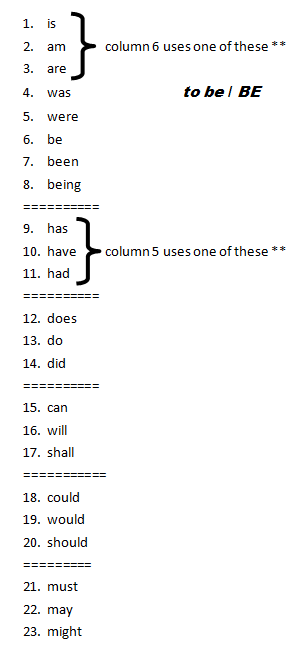
For example, in the sentence, 'Shyla can ride her sister's. ) A helping verb always stands in front of a main verb. (A helping verb is also known as an auxiliary verb. Together the helping verb and the main verb form a verb phrase. There are some other directions that we use less often, including after, through, over, across, around, past, together and apart. In English grammar, a helping verb is a verb that comes before the main verb (or lexical verb) in a sentence. Sometimes we use the directional meaning in a metaphorical way. These directional meanings are in GROUP 1.Įach particle also has some special meanings. What are the 3 types of verb There are three types of verbs: action verbs, linking verbs, and helping verbs.Action verbs are words that express action (give, eat, walk, etc.) or possession (have, own, etc.). We sit by the toy box and put the blocks IN and take them OUT. What are the 4 types of verbs There are four TYPES of verbs: intransitive, transitive, linking, and passive. We sit ON the stool and get OFF the stool. We take a car and pick it UP and put it DOWN. The most frequently used are up/ down, in/ out, on/ off and back/ away. To understand them, you have to understand the little words – we call them particles.

Don’t try to learn “Phrasal verbs with take” or “Phrasal verbs with get” or “Phrasal verbs with go”.
However, often English course books present them in a completely random way which makes them very difficult to learn.

HELPING VERBS LIST WITH EXAMPLES HOW TO
The negative forms of these words ( can’t, don’t, won’t, etc.) are also helping verbs.How Phrasal Verbs Work and How to Learn Them We will eat pie. The sun will rise tomorrow at 6:03. Helping VerbĮxpress tense (the tense depends on the conjugation of to be is is present, was is past, will be is future, etc.) and a sense of continuity.Įxpress tense (the tense depends on the conjugation of to be are is present, were is past, will be is future, etc.) and indicate the passive voiceĮxpress tense (the tense depends on the conjugation of to be are is present, were is past, will be is future, etc.) and indicate a sense of completion A full list of helping verbs can be found here. The following table provides a short list of some verbs that can function as helping verbs, along with examples of the way they function. Has is a helping verb used in expressing the tense of given.The helping verb are indicates the present tense, and adds a sense of continuity to the verb finding.Researchers are finding that propranolol is effective in the treatment of heartbeat irregularities.Do is a helping verb accompanying the main verb want, used here to form a question.



 0 kommentar(er)
0 kommentar(er)
